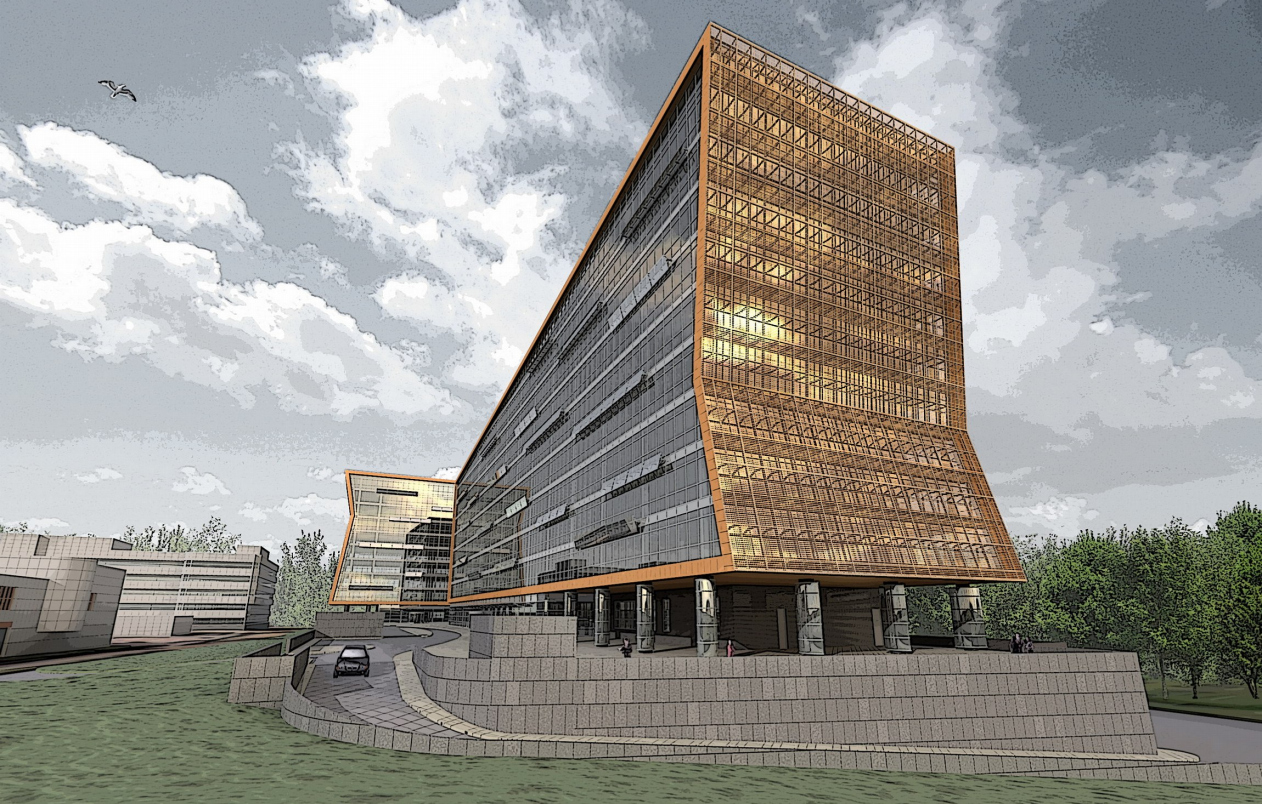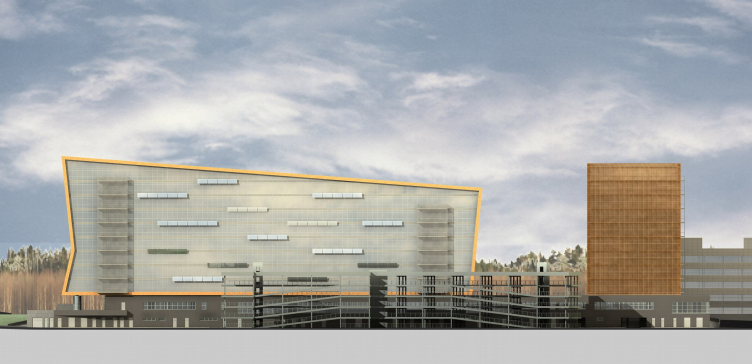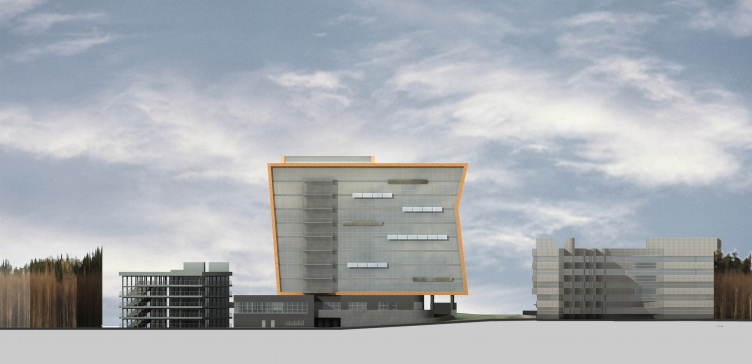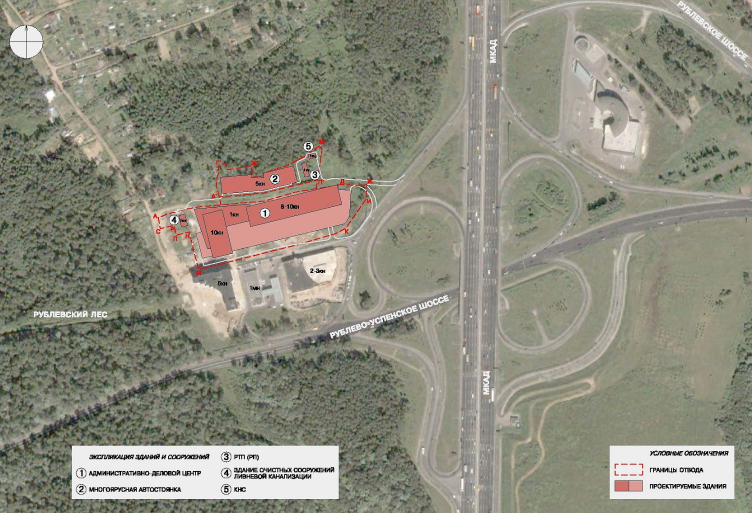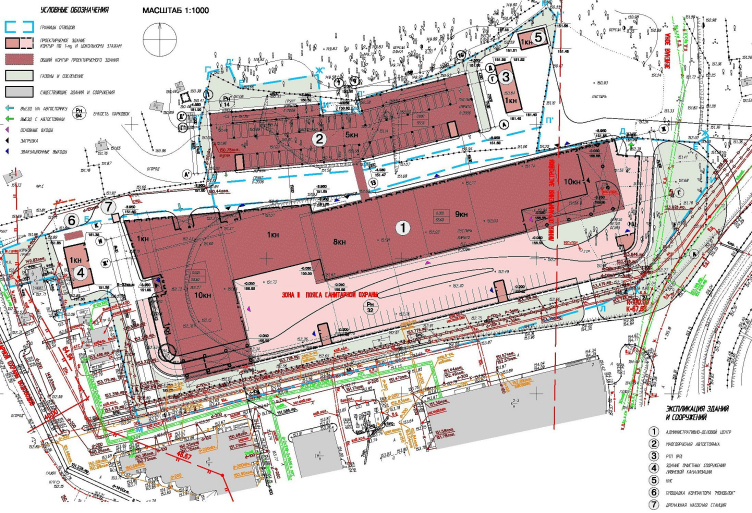The complex includes two 10-storeyd buildings of different length placed perpendicularly to each other. Firstly, it is so because the site is much stretched and it is located on crossing of the two highways with high traffic: MKAD and Rublevo-Uspenskoe. Driving along any of these routes one will be able to see slightly broken outline of the glass plane of one construction, and copper lace of wall end of another.
It seems the aim of the authors was – nothing superfluous. In the end there are two alike large volumes. Architects define them as the "round stones" raised – levitate – over the ground on shining, wrapped in curved glass legs. Buildings are so similar that it seems they have been cut with some huge knife from something very large, like slices of bread or a loaf. That large was inside glass, and outside had copper skin – so, on "cuts” facades are entirely glass, and around are wrapped in golden copper "ribbon". Its outlines consist of straight lines, pointed corners, and together they force even a swift-passing driver feel the "tension" of metal. But while "cutting" there remained “crumbs” on glass planes – these are “cold” glass planes turned at turned at different angles – some of them reflect the sky, some reflect the ground. These elements are entirely decorative – their role is to enliven giant glass planes. They are like open hoppers – remember, for example, the stained-glass window of the garage constructed by Konstantin Melnikov on Sushevsky, so here something very like by Melnikov.
So, the project is modest in details: pseudo-“hoppers” on glass planes and lace of copper end walls, this is all can be marked about details. Volume is the main scene, the shape of two buildings is very one-piece. And like any one-piece shape it leads to design comparisons – makes us think of something more – 10storey building – with something familiar and smaller. It is easier to understand these constructions, so there appear parallels. So, the buildings are like postwar radio phonograph on supports, wrapped in stripes of dark red plywood fine sources of exotic voices and new music.
But their outlines are not rounded, but sharp angled. Plain figures seem to “jerk" under some invisible attraction in result of which side lines of facades bent and stopped. This jerk in combination with curves reminds of another object of that romantic time – American cars with "fins". Applying the so-called "fins" – special high spots of body – distinguished automobile design in the USA, and therefore worldwide, during almost next 10 years. This is automobile romanticism of 50-60’s. Shining “Fords” and “Packard”, speed, freedom and a rock'n roll. And pleasant excitement of driving already forgotten in Moscow.
As there is almost no building development around, except for the gasoline filling station and a 5storey office building near the smaller construction, the whole complex "communicates" only with forest area and tapes of roads. Figuratively and practically it is designed for movement, maximal effect of perception of volumes can be from a window of a speeding vehicle. This is proved by computer movement modeling of a car speeding along highway by the complex – must notice, “Sergey Kiselev and Partners” all their projects test on animated 3D model. That gives greater accuracy.
Copper end faces are clearly seen from afar. The authors say the idea to use copper came later. The client, "Weststroymet” company, is working with rolled metal products, and facing with metal elements should reflect working sphere of the company. Originally they wanted to use patina iron, popularity of this material among Moscow builders grows from day to day, but then refused the idea because of possible difficulties in operation. Then decided to make "wrapping" of facades of copper. Or rather, there will be used yellow-golden alloy of copper and aluminum by Tecu-Gold – the material which has not been yet certificated in Russia and certainly this adds more work for architects, “sufferings in sake of beauty” when it concerns here need to get approval for new facing subvariety.
Both buildings are on single stylobate which is the base. Stylobate and its solid fencing are faced with natural stone, light grey granite. There are no basement spaces because ground there is quite humid, uncomfortable, so various spaces are located in the ground floor. Buildings are also connected at the level of 1 storey with a warm passage. This general inner space will be turned into a public zone with diners, restaurant, bank office and small shops, and also halls and entries to lifts. We may say this is indoor area is imitating a street environment, nearby the administrative and business centre there are no other public zones, and external design of the inner area of complex is the space of separation between automobile entrances to parkings, sidewalks and lawns.
Another interesting thing is that this is the first project out of the city line for the company “Sergey Kiselyov and Partners” (about 300 their projects were designed for Moscow, except for the very first one and uncharacteristic). But location out of city line is figurative, address of the complex is Rublevo-Uspenskoe highway, 1. Moscow is near. And still the architectural image is changing under influence of speed on MKAD and automobile environment. The true context for these buildings becomes cars, not surrounding constructions. That is logical, nowadays automobiles have design perfected to smallest details, and it is right to compare with them, they are real context here.
In total, such architecture of movement is simply impossible in a city centre, its beauty will be lost there, will be out of place, like a car pressed in stream of cars. But here, on the way out of Moscow simple and directed forms bring exciting feeling of freedom to those who look at it. Usually architecture releases a person on a vertical, directing upwards. The complex on Rublevo-Uspenskoe highway symbolizes more rare freedom of movement — horizontal.
